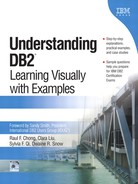Chapter 4
| A1: | The Task Center lets you schedule scripts containing SQL statements and/or DB2 commands to be run at specific times. |
| A2: | There is no equivalent DB2 tool in the Linux/UNIX platforms. The Linux/UNIX shell would be equivalent to the DB2 Command Window. |
| A3: | The registry variable is DB2OPTIONS. |
| A4: | When you plan to copy a command or statement that has carriage returns and then paste it into the CLP, it is best to use this method. |
| A5: | The terminate command. |
| A6: | You can invoke Visual Explain from the Command Editor. Type a query, and then choose either the Execute and Access plan or Access Plan button. |
| A7: | The Development Center tool. |
| A8: | No. The Control Center can be used to administer DB2 for Linux, UNIX, and Windows databases as well as DB2 for OS/390 and z/OS databases. |
| A9: | The Journal keeps track of DB2 messages; therefore, review the Journal messages tab. |
| A10: | Access the Information Center from the Internet at http://publib.boulder.ibm.com/infocenter/db2help. |
| A11: | B and C. You can enter SQL statements and DB2 CLP commands in the Command Line Processor (CLP) or in the Command Editor. |
| A12: | B. The default termination character is a semi-colon (;). |
| A13: | E. By default the CLP has autocommit enabled, and this causes the CLP to issue a commit statement automatically after every statement. Therefore, in this case, the CLP will issue a commit four times—after each entry in the input file. |
| A14: | C. The Health Center will alert you when actions in the database exceed thresholds for performance-related characteristics that you have defined. |
| A15: | B and E. The Memory Visualizer will track the memory used by DB2 on your system and will plot/graph this memory usage for you automatically if you desire. The db2mtrk tool is the command line interface to the same information, and it will provide the same information in a text-based report. |
| A16: | A. By default the CLP has autocommit enabled, which causes the CLP to issue a commit automatically after every statement. However, the +c flag tells the CLP to disable autocommit; therefore, in this case, the CLP will not issue a commit. Since there is no explicit commit statement, there will be no commits during the processing of this file. |
| A17: | B. To set a termination character you need to use the -td option, and to set the input file you need to use the -f option. However, if you specify a value for an option, you cannot string the options together. Therefore the correct answer is B. |
| A18: | C and D. db2 ? SQL-911 is not commonly used, but it works. db2 ? SQL911N is most often used. Note that the N after the 911 is optional. |
| A19: | D. Repeat is not a DB2 CLP command and can't be run in interactive mode. |
| A20: | C and D are allowed from the CLP in interactive mode. A is not allowed since you cannot prefix the command with db2 when in interactive mode. B is a DB2 system command, and it can only be executed from the Command Window or the Linux/UNIX shell. |
..................Content has been hidden....................
You can't read the all page of ebook, please click here login for view all page.
